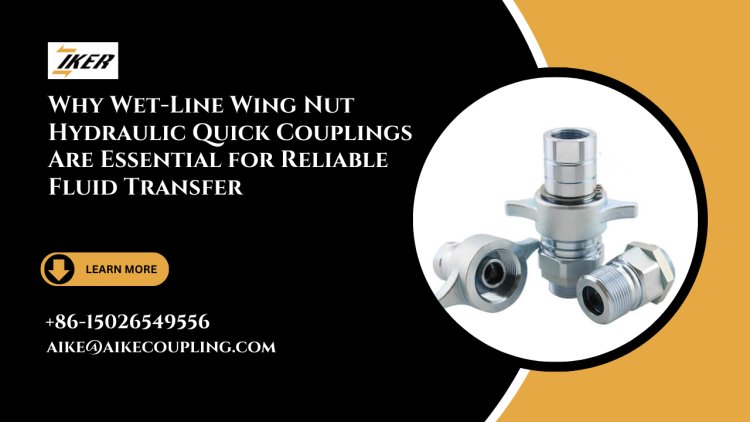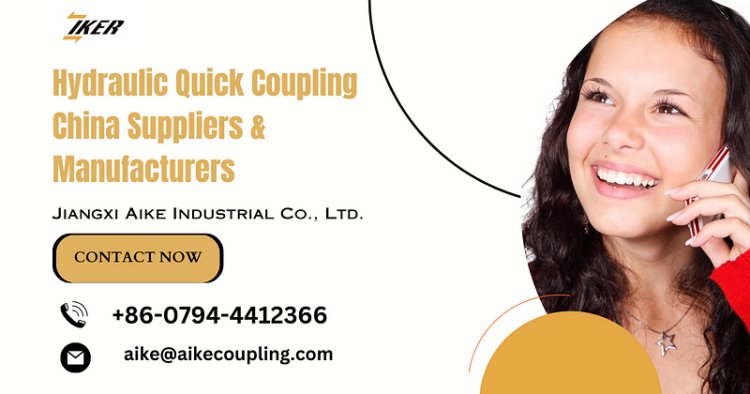Why Wet-Line Wing Nut Hydraulic Quick Couplings Are Essential for Reliable Fluid Transfer
Share this Post to earn Money ( Upto ₹100 per 1000 Views )

In the realm of hydraulic systems, ensuring the reliable transfer of fluids is crucial for maintaining operational efficiency and safety. Among the many components that contribute to this reliability, the choice of hydraulic quick couplings plays a significant role. One type that has garnered attention for its effectiveness and functionality is the wet-line wing nut hydraulic quick coupling.
Understanding Wet-Line Wing Nut Hydraulic Quick Couplings
What Are Wet-Line Wing Nut Hydraulic Quick Couplings?
Wet-line wing nut hydraulic quick couplings are specialized connectors designed for fluid transfer in hydraulic systems. They are characterized by their unique wing nut mechanism, which allows for quick and easy coupling and uncoupling of hydraulic lines. The "wet-line" aspect refers to their ability to handle fluid transfer while the system is in operation, making them highly suitable for applications where disconnection and reconnection must be done without interrupting the flow of fluid.
The Importance of Reliable Fluid Transfer
Reliable fluid transfer is fundamental to the performance and safety of hydraulic systems. Efficient fluid management ensures that hydraulic power is transmitted effectively, reducing the risk of system failures and downtime. In industries such as agriculture, construction, and manufacturing, where hydraulic systems are integral to operations, the choice of hydraulic quick couplings directly impacts overall system reliability and productivity.
Key Features of Wet-Line Wing Nut Hydraulic Quick Couplings
1. Quick Connect/Disconnect Mechanism
One of the standout features of wet-line wing nut hydraulic quick couplings is their quick connect/disconnect mechanism. The wing nut design allows users to rapidly and securely connect or disconnect hydraulic lines with minimal effort. This feature is particularly valuable in applications where frequent coupling and uncoupling are required, saving time and enhancing operational efficiency.
2. Leak-Free Operation
Wet-line wing nut hydraulic quick couplings are engineered to provide a leak-free connection, even under high pressure and during fluid transfer. The wing nut mechanism ensures a tight seal between the coupling halves, preventing fluid leakage and minimizing the risk of spills or contamination. This leak-free operation is crucial for maintaining system integrity and preventing potential hazards.
3. Durable Construction
Durability is a key consideration in the design of wet-line wing nut hydraulic quick couplings. These couplings are typically constructed from high-quality materials such as stainless steel or brass, which offer resistance to corrosion, wear, and mechanical stress. The robust construction ensures that the couplings can withstand the rigors of demanding hydraulic applications and provide long-lasting performance.
4. Compatibility with Various Fluid Types
Wet-line wing nut hydraulic quick couplings are designed to handle a wide range of fluids, including hydraulic oils, water, and chemicals. This versatility makes them suitable for various applications and industries. Whether the system operates with standard hydraulic fluids or more specialized liquids, the coupling's compatibility ensures reliable fluid transfer across different scenarios.
5. Temperature and Pressure Resistance
Hydraulic systems often operate under extreme temperature and pressure conditions. Wet-line wing nut hydraulic quick couplings are engineered to perform reliably in these challenging environments. Their ability to withstand high pressures and temperature variations ensures consistent performance and safety, even in demanding applications.
6. Ease of Use
The user-friendly design of wet-line wing nut hydraulic quick couplings simplifies the process of connecting and disconnecting hydraulic lines. The wing nut mechanism allows for easy hand tightening, eliminating the need for additional tools or equipment. This ease of use enhances efficiency and reduces the risk of errors during the coupling process.
7. Enhanced Safety Features
Safety is a paramount concern in hydraulic systems, and wet-line wing nut hydraulic quick couplings are designed with this in mind. The secure connection provided by the wing nut mechanism helps prevent accidental disconnections and ensures that the coupling remains firmly in place during operation. Additionally, the leak-free design reduces the risk of fluid spills and environmental contamination.
8. Versatility in Applications
Wet-line wing nut hydraulic quick couplings are versatile components that can be used in a variety of hydraulic systems and applications. From agricultural machinery and construction equipment to manufacturing processes and industrial machinery, these couplings offer reliable fluid transfer across diverse settings.
Advantages of Using Wet-Line Wing Nut Hydraulic Quick Couplings
1. Increased Efficiency
The quick connect/disconnect feature of wet-line wing nut hydraulic quick couplings enhances operational efficiency by reducing the time required for coupling and uncoupling. This increased efficiency is particularly beneficial in applications where rapid fluid transfer is essential for maintaining productivity.
2. Reduced Downtime
The reliable, leak-free operation of wet-line wing nut hydraulic quick couplings helps minimize downtime caused by fluid leaks or connection failures. By ensuring a secure and stable connection, these couplings contribute to the smooth and continuous operation of hydraulic systems.
3. Cost Savings
Investing in high-quality wet-line wing nut hydraulic quick couplings can lead to long-term cost savings. The durable construction and reliable performance of these couplings reduce the need for frequent replacements and maintenance, lowering overall operational costs.
4. Improved Safety
The secure connection and leak-free design of wet-line wing nut hydraulic quick couplings enhance safety by preventing fluid spills and reducing the risk of accidents. This improved safety is crucial for protecting both personnel and equipment in hydraulic applications.
5. Enhanced Flexibility
The versatility of wet-line wing nut hydraulic quick couplings allows them to be used in a wide range of hydraulic systems and fluid types. This flexibility makes them a valuable addition to various industrial and agricultural applications.
Choosing the Right Wet-Line Wing Nut Hydraulic Quick Coupling
1. Assess Your System’s Requirements
To select the appropriate wet-line wing nut hydraulic quick coupling, begin by assessing the specific requirements of your hydraulic system. Consider factors such as pressure ratings, fluid types, temperature ranges, and connection sizes. Understanding these requirements will help you choose a coupling that meets your system’s needs.
2. Consult with Industry Experts
Consulting with industry experts or hydraulic system professionals can provide valuable insights into the best coupling options for your application. Experts can offer guidance on selecting couplings with the right features and performance characteristics.
3. Evaluate Manufacturer Options
Research and evaluate different manufacturers of wet-line wing nut hydraulic quick couplings. Look for manufacturers with a reputation for quality and reliability. Consider factors such as product reviews, certifications, and warranty offerings when making your decision.
4. Test and Verify Performance
If possible, test and verify the performance of the wet-line wing nut hydraulic quick couplings in real-world conditions before making a final decision. Testing allows you to assess their suitability for your specific application and ensure that they meet your performance expectations.
5. Consider Long-Term Costs
When choosing wet-line wing nut hydraulic quick couplings, consider the long-term costs associated with maintenance, replacements, and operational efficiency. Investing in high-quality couplings may involve a higher initial cost but can lead to cost savings over time due to reduced maintenance and improved performance.
Wet-line wing nut hydraulic quick couplings are essential components for reliable fluid transfer in hydraulic systems. Their quick connect/disconnect mechanism, leak-free operation, durable construction, and versatility make them valuable for various applications. By understanding the key features and benefits of these couplings, you can make informed decisions that enhance the efficiency, safety, and performance of your hydraulic systems. Investing in high-quality wet-line wing nut hydraulic quick couplings ensures dependable fluid transfer and contributes to the overall success of your hydraulic operations.
FAQs
1. What are wet-line wing nut hydraulic quick couplings used for?
Wet-line wing nut hydraulic quick couplings are used to connect hydraulic lines in systems where fluid transfer occurs while the system is in operation. They provide a secure, leak-free connection with a quick connect/disconnect mechanism.
2. How do I determine the right size and pressure rating for my hydraulic quick coupling?
Choose a coupling with a size and pressure rating that matches the specifications of your hydraulic system. Consider factors such as the system’s operating pressure, fluid type, and connection size to ensure compatibility.
3. What materials are commonly used in wet-line wing nut hydraulic quick couplings?
Common materials include stainless steel, brass, and aluminum. The choice of material depends on factors such as corrosion resistance, durability, and the specific requirements of your application.
4. How can I ensure a leak-free connection with wet-line wing nut hydraulic quick couplings?
Ensure a leak-free connection by selecting high-quality couplings with reliable sealing mechanisms. Proper installation and regular maintenance also contribute to preventing leaks.
5. What should I consider when choosing a manufacturer for wet-line wing nut hydraulic quick couplings?
Consider factors such as the manufacturer’s reputation, product quality, certifications, customer reviews, and warranty offerings. Choose a manufacturer known for producing reliable and high-performance couplings.

















